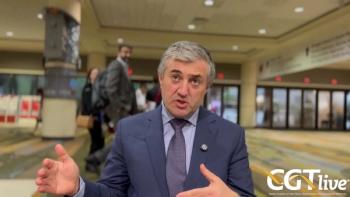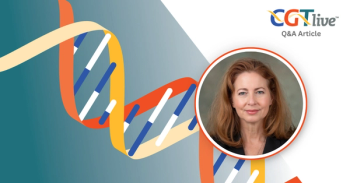
NKT Cell Therapy KUR-502 Effective for B-Cell Malignancies
KUR-502 elicited promising response rates for patients with relapsed or refractory B-cell malignancies in a phase 1 study.
The allogeneic CD19-directed CAR natural killer T (CAR-NKT)–cell therapy KUR-502 elicited a 6-month complete response (CR) rate of 29% for patients with relapsed or refractory (R/R) B-cell malignancies, according to updated interim findings from the phase 1 ANCHOR study (NCT03774654) presented at the
Interim findings from the dose escalation study were available for 7 patients, 5 with B-cell non-Hodgkin lymphoma (NHL) and 2 with B-cell acute lymphoblastic leukemia (ALL). The overall response rate (ORR) with KUR-502 across patients was 57%, which was assessed 4 to 6 weeks post-infusion by Lugano criteria. This consisted of a CR rate of 43% and a partial response (PR) rate of 14%. An additional patient experienced stable disease (SD) for a disease control rate (DCR) of 71%. Additionally, there were 2 responses observed following relapse on a prior autologous CAR T-cell therapy.
"Despite the small numbers, we've shown that adoptive transfer of allogeneic CD19 CAR-NKT cells is feasible and safe. We've seen some significant responses, even at the low levels we've tested so far. Importantly, 2 out of 4 responses were in patients in whom prior autologous CAR T-cell therapy had failed," lead investigator Carlos Ramos, MD, Baylor College of Medicine, Texas Children's Hospital and Houston Methodist Hospital, Center for Cell and Gene Therapy, said during a presentation of the results. "We definitely need to treat more patients. I believe this first-in-human clinical evaluation of allogeneic CAR-NKT cells suggests they are a promising platform for off-the-shelf cancer immunotherapy."
KUR-502 consists of allogeneic NKT cells that have been engineered using a retrovirus to co-express a CD19-specific CAR, IL-15, and short hairpin RNA (shRNA) that works to downregulate beta-2 microglobulin (B2M) and CD74, which are HLA class I and class II molecules, respectively. On top of these engineered qualities, NKT cells are also monomorphic CD1d-restricted and Vα24-invariant, making them non-alloreactive. These attributes are thought to prevent the risk of graft-vs-host disease (GVHD) with an "off-the-shelf" product.
For KUR-502, NKT cells were collected by leukapheresis from 1 HLA-unmatched donor, transduced, and then expanded ex vivo for 14 days. The final product had 99.8% NKT purity (0.04% were T cells) and was cryopreserved. There was a 2869-fold expansion in cells, providing enough CAR-NKT cells from 1 healthy donor for the full phase 1 study, according to Ramos.
The open-label phase 1 study enrolled patients into 2 cohorts: 1 for those with non-ALL B-cell malignancies (n = 5) and the other for those with ALL (n = 2). Treatment was administered in the outpatient setting and those enrolled received either dose level (DL) 1 (n = 5), which was 1 x 107/m2 NKT-CAR+ cells, or DL2 (n = 2), which consisted of 3 x 107/m2. Prior to administration of KUR-502, patients received 3 daily doses of lymphodepleting chemotherapy with fludarabine (30mg/m2 per day) and cyclophosphamide (500mg/m2 per day).
In patients with NHL (n = 5), responses consisted of 2 CRs, 1 PR, and 1 SD, for an ORR in this cohort of 60% and a DCR of 80%. There were 2 CRs that persisted for more than 6 months, including 1 that remained ongoing at 34 weeks. In those with ALL (n =2), there was 1 CR with incomplete hematologic recovery seen at 6 weeks. There were no SDs or PRs in this group, for an ORR and DCR of 50%.
The responses seen following relapse on autologous CAR T-cell therapy consisted of 1 CR and 1 PR, both in patients with diffuse large B-cell lymphoma. One was experienced at DL1 and the other at DL2. The patient with a CR was at 57 year old woman treated with DL2 of KUR-502. She had previously received axicabtagene ciloleucel (Yescarta), tafasitamab (Monjuvi), and polatuzumab vedotin (Polivy). This CR had persisted for almost 9 months at the time of the analysis, Ramos noted.
No cases of GVHD or neurotoxicity syndrome were observed, and the incidence of cytokine release syndrome (CRS) was low with only 3 events seen in 2 patients both in the ALL cohort. All CRS events were deemed grade 1 in severity. The most frequently observed adverse events were nausea and grade 3/4 hematologic toxicities, that were most likely related to the lymphodepletion chemotherapy.
“Encouraging data from the interim update of the ANCHOR study further support the promising efficacy and favorable safety profile of KUR-502 in heavily pretreated patients with hematological malignancies,” Dan Lang, MD, president of Athenex Cell Therapy, the company developing the treatment, said in a statement. “It is exciting to see the therapeutic benefit of our CAR-NKT cell therapy persists as the ANCHOR study matures, particularly in patients who have already progressed on autologous CAR-T therapy. We intend to collect additional patient data as we expand the study to include more sites and look forward to providing another update later this year.”
When possible, patients underwent core biopsies for further assessment. These typically took place 2 to 5 weeks post-infusion of KUR-502. In biomarker analyses, beyond 3 hours post-infusion, investigators could no longer detect CAR-NKTs cells in the peripheral blood in the first 3 patients NHL treated with KUR-502; however, expansion was seen at higher doses.
"Expansion of these cells in peripheral blood is quite limited," said Ramos. "Although we can detect their expansion immediately after infusion, even at low dose levels, we can only detect these cells in the peripheral blood by flow cytometry and later by Q-PCR in patients with higher doses infusion, suggesting a dose relationship."
Follow-up from the study will remain ongoing and additional patients will be recruited. The study hopes to enroll 48 participants. As the dose continues to be escalated, dose level 3 of 1 x 108/m2 will also be administered, to continue to search for a maximum tolerated dose and dose limiting toxicity (NCT03774654).
For more coverage of the Tandem Meetings 2022,
Reference
Ramos CA, Courtney AN, Robinson SN, et al. Allogeneic NKT Cells Expressing a CD19-Specific CAR in Patients with Relapsed or Refractory B-Cell Malignancies. Presented at: Transplantation & Cellular Therapy Meetings of ASTCT and CIBMTR; April 23-26, 2022; Salt Lake City, UT. Accessed April 25, 2022. https://tandem.confex.com/tandem/2022/meetingapp.cgi/Paper/19125
Newsletter
Stay at the forefront of cutting-edge science with CGT—your direct line to expert insights, breakthrough data, and real-time coverage of the latest advancements in cell and gene therapy.
















































